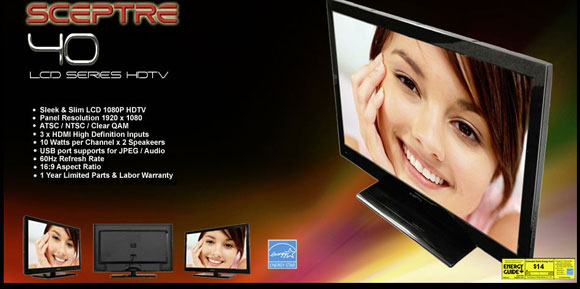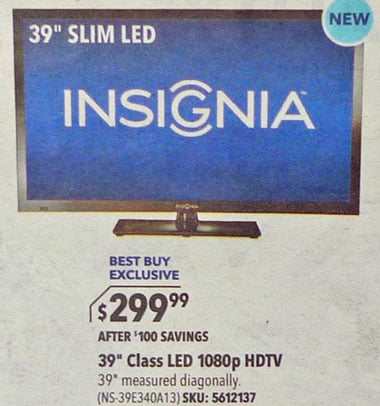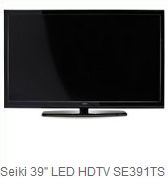
Just how big is that 40-inch TV? It could be smaller — much smaller — than 40 inches. TV sellers are misleading consumers into believing the actual “active” screen is bigger than it really is, according to HD Guru's own research. Deceived consumers think they're getting a better buy, finding a bigger screen HDTV for less money than competing models.
In 2008, the U.S. Federal Trade Commission issued guidelines to TV makers and sellers to ensure consumers aren’t deceived. But our search of TV seller and brand websites found a significant number of them not complying, providing confusing or inaccurate screen-size information or burying the correct data on secondary pages, past the “add to cart” page.
In the last few years TV makers and sellers have adopted the term “XX class” to show screen size. But just because a TV is in a 40-in. "class," you can't assume the screen is actually 40 inches diagonal. (HDTV screens are always measured in the diagonal.) In fact, if you see the word "class" mentioned in reference to screen size on a TV ad, the seller may be trying to obscure a true, smaller size.
We contacted an FTC representative to learn the guidelines. The FTC spokesman told HD Guru:
If a size “Class” is listed it must be no greater than one-half of an inch larger than the HDTVs actual active area. If the “Class” is greater, the real screen size must be accurately listed right along with the class listing. This rule applies to all advertisements, websites, and anywhere the TV is offered for sale.
Many HDTV screens are smaller than their ads state. While most are within the acceptable half-inch range, some are not. And even when they are within that range, retailers do not report the size discrepancy according to the government's rules.
Walmart

We quickly found a Sceptre 40-in. "class" TV offered by Walmart. You must go to the specifications page to learn that the true screen size only measures 38.5 inches.
This is no insignificant amount of real estate. The area difference between 38.5 inches and 40 inches diagonal amounts to more than 50 square inches. The difference in size between actual and advertised is more than an iPad screen.
After HD Guru contacted Walmart, the company corrected the top listing by including the true measurement of 38.5 inches. However, Walmart continues to violate the FTC guidelines, because it is really a “39-inch class,” and has not responded to HD Guru regarding this second issue.
HD Guru also has not heard back from Sceptre. While the website lists certain TVs in the 40 "class" without any reference to their actual diagonal screen measurements on the promotional page, the company apparently has started to add actual measurements to its specifications pages, perhaps as a result of HD Guru's inquiry.
Sears
Sears states "screen size (by diagonal measure)" to be 39 inches. The Seiki website says "Size: 39-in. diagonal screen." This is false.
A TV maker and an industry analyst confirm that LCD panels in the 39-inch class come from just two manufacturers, and both cut their TVs with active display areas measuring 38.5 inches in diagonal. Further inspection of the factory spec sheets from the TV makers confirms this. Therefore, it would be impossible for Seiki to have an LCD screen measuring 39 inches. The TVs can be in the 39-inch "class," according to FTC rules, but the correct measurement still must be displayed.
Best Buy
Best Buy does not state the actual size on the listing page as required. It also misled consumers by posting, in its Sept. 2 weekly circular, the inflated screen size for its 39-inch class Insignia, which is really 38.5-inches. The company also incorrectly lists the actual screen size of a 39-inch Haier.
 We received a response to our inquiry from Best Buy corporate spokesperson by email regarding its non-compliance to the FTC guideline. It states:
We received a response to our inquiry from Best Buy corporate spokesperson by email regarding its non-compliance to the FTC guideline. It states:
“Thank you for bringing this to our attention. We do adhere to FTC regulations and guidelines as they pertain to screen sizes for TVs. You were correct in that our 9/2 circular had inaccurate information with regard to the Insignia 39″. This was unfortunately a human error and is listed correctly on our website. The issue with the Haier 39″ TV is currently being corrected on our website as well.”
We checked back on the BB website and found the prime listings of HDTVs still do not contain the actual screen size, even though you can “add to cart” without the disclosure. We asked why and will publish a response when we receive it.
Recommendations
Prospective HDTV purchasers should go to the manufacturer’s website to attempt to learn the true active screen measurement before making a buying decision. If it is not given, bring a tape measure to the dealership to confirm the true size of the picture. In some cases, this is the only way to know the real screen size. You may learn the sale ad is inaccurate and the TV for its give true screen size is not the bargain you thought it was.















From Kristy on September 19, 2012 :: 10:40 am
This is helpful, not just to alert us to the problem when we shop for TVs, but to hold manufacturers’ feet to the fire by broadcasting it from your bully pulpit. Thanks for looking out for consumers’ interests.
Reply